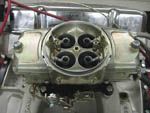
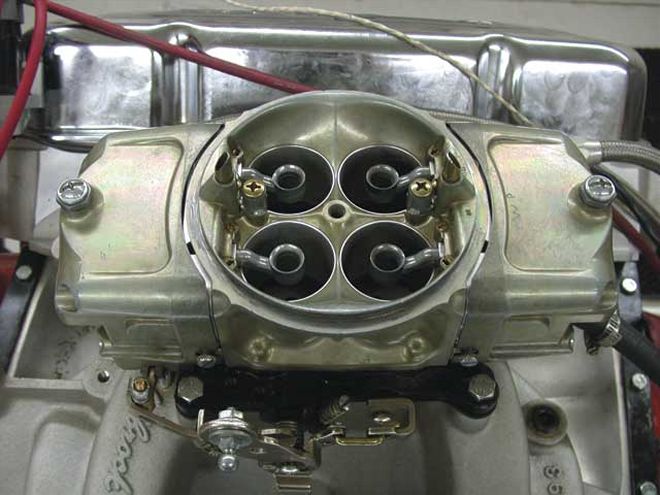 Want to get the most from a carb? Understanding and optimizing thevarious tuning points to really dial it in makes all the difference.Entry-level carbs have the fewest tuning options, while atop-of-the-line unit like this Race Demon RS features an incrediblenumber of tuning possibilities. With so many tuning permutationsavailable, you'd better know your stuff before digging in.
Want to get the most from a carb? Understanding and optimizing thevarious tuning points to really dial it in makes all the difference.Entry-level carbs have the fewest tuning options, while atop-of-the-line unit like this Race Demon RS features an incrediblenumber of tuning possibilities. With so many tuning permutationsavailable, you'd better know your stuff before digging in.
Tuning a carburetor can be done on many levels, depending on your ironand how you need to use it. A good ear and a slot-head screwdriver areall it takes for a curbside calibration on an old Carter BBD two-barrelsloshing gas down the pipes of a greasy 318. Not to shock you with thecontrast, but top Pro Stock teams spend more on carb calibration and therequired facilities and equipment than it would take to buy a room fullof Mopar Muscle staffers. Where do you fall on the scale?
Even a kidwith a screwdriver can benefit from a little knowledge of what thattwist of the screw is doing, while more serious Mopar motorheads cangain a fistful of power with a well-considered calibration. Carbs thesedays are available with more adjustments and tuning points than ever.Generally, entry-level carbs have fewer tuning points, often just theprimary main jets, idle speed, and mixture. Moving up the scale, thehigher-end carbs up the ante with replaceable secondary jets, whileracier carbs may incorporate four-corner idle adjustments, primary andsecondary idle speed screws, and perhaps replaceable air bleeds for theidle and main circuits. At the top end of the scale are the race carbs,which feature the greatest level of tuneability.
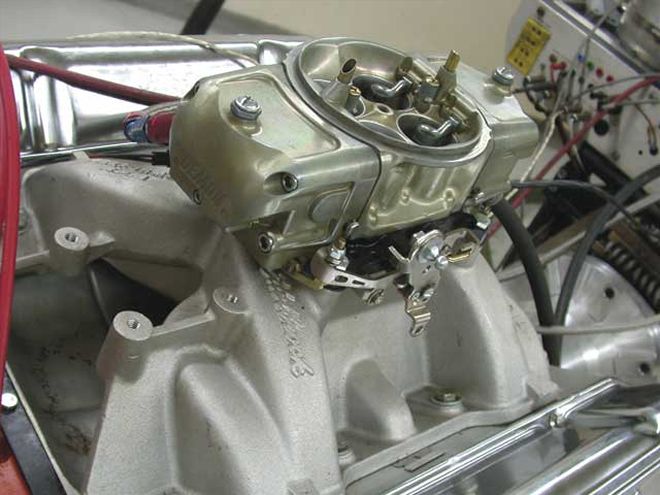 We selected the Race Demon RS to run through our tuning examples, simplybecause this carb is the most adjustable on the market. The carb isadjustable for venturi size and flow rate via replaceable venturisleeves. Other tuning points include idle speed adjustment at both theprimary and secondary throttle shafts, typical pump adjustments, fourcorner idle mixture, replaceable jets at both ends, replaceable powervalves, replaceable high-and-low speed air bleeds, removable boosters,air bypass jet provision, screw-in idle feed restriction, andreplaceable emulsion bleeds.
We selected the Race Demon RS to run through our tuning examples, simplybecause this carb is the most adjustable on the market. The carb isadjustable for venturi size and flow rate via replaceable venturisleeves. Other tuning points include idle speed adjustment at both theprimary and secondary throttle shafts, typical pump adjustments, fourcorner idle mixture, replaceable jets at both ends, replaceable powervalves, replaceable high-and-low speed air bleeds, removable boosters,air bypass jet provision, screw-in idle feed restriction, andreplaceable emulsion bleeds.
Demon's top-of-the-lineRace Demon RS includes all the tuning provisions mentioned, as well asreplaceable venturi sleeves, boosters, idle feed restrictions, emulsionbleeds, and auxiliary air metering. As an uncompromised race carb, thetuning flexibility is designed in, and the custom tuning possibilitiesare staggering. Tuning one correctly requires more than curbsideguesswork; you'd better have a well-instrumented dyno and more than alittle know-how before digging in too deep.
Fortunately, the factorycalibration on carbs, including the race units, put the more esotericsettings in a range that will seldom require custom tuning. Generally,jet changes alone will provide a carb that's very close. Even so, thereare more screwdriver slots in carbs than ever before, so a rundown onwhat all those little things do is worth a look. For your entertainment,we brought the mother of all tuner's carbs--the Race Demon RS--alongwith a burly 440 for a session on the Westech dyno, all to hunt downthat elusive "magic" tune.
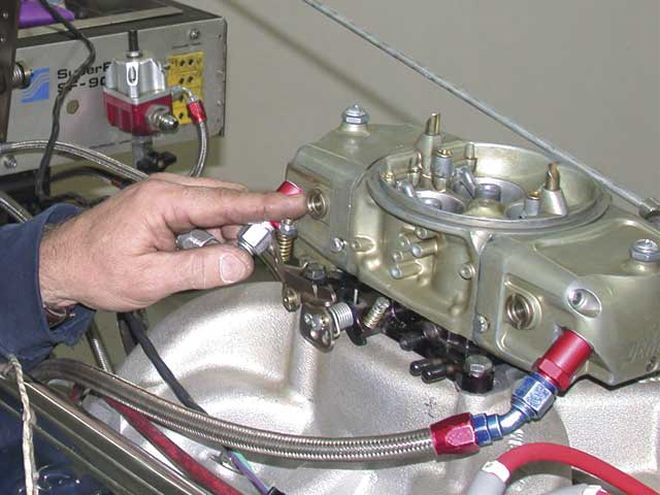 Before any of the more serious tuning can begin, and before the engineis first fired with a new carb, get the base adjustments set first.These simple procedures are often bypassed, causing headaches later on.First on the list is the float level, made easy with Demon's large bowlsight glass. Brule recommends the fuel level adjustment be set one-halfto two-thirds of the way up the side glass.
Before any of the more serious tuning can begin, and before the engineis first fired with a new carb, get the base adjustments set first.These simple procedures are often bypassed, causing headaches later on.First on the list is the float level, made easy with Demon's large bowlsight glass. Brule recommends the fuel level adjustment be set one-halfto two-thirds of the way up the side glass.
WHAT IS IT: Idle speed screws.
WHO SHOULD CARE: This one is for everyone, from the kid with the BBD tothe heads-up racer running a pair of quads.
WHAT IT DOES: Sets the position of the throttle plates for idle.
WHAT CHANGES DOES IT MAKE: Screw in-faster idle; screw out-slower idle
TUNING TIPS YOU NEED TO KNOW: Idle speed is a function of the airgetting in, at the correct mixture. The idle should feed off the idlecircuit, which includes the idle port and partially the transition slot.Large idle openings position the throttle blades too far past the idleport for the mixture screws to be effective. Always use the least amountof idle opening to achieve the required idle rpm. If the mixture screwsdo not seem to have any effect on idle quality--as can happen whentuning with large cams with poor idle vacuum--chances are the blades areopen too far. Read on for other ways to get air in and close thethrottle idle setting. The rule of thumb here is to set the throttleblades to expose just a small portion of the transition slot below thebutterflies.
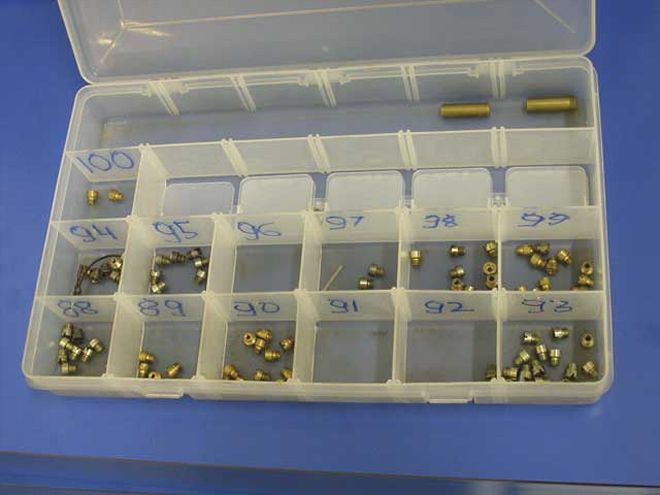 Adjustment is made by loosening the lock screw, and turning theadjusting nut out to raise fuel level, and turning it in to lower it.Check the fuel level with the fuel pumps on (electric) or the enginerunning (mechanical).
Adjustment is made by loosening the lock screw, and turning theadjusting nut out to raise fuel level, and turning it in to lower it.Check the fuel level with the fuel pumps on (electric) or the enginerunning (mechanical).
WHAT IS IT: Idle mixture screws.
WHO SHOULD CARE: Anyone with a carb and consciousness.
WHAT IT DOES: Sets the quantity of mixture (idle emulsion) entering theengine through the idle circuit.
WHAT CHANGES DOES IT MAKE: Screw out for more fuel, richer; screw in forless fuel, leaner.
TUNING TIPS YOU NEED TO KNOW: Always adjust the screws the same amount,keeping the settings at the same number of turns out from a lightlyseated baseline. Demon carbs can be set at a baseline of one turn fromseated, and fine-tuned from there. If the mixture screws have no effect,look for an overly open idle speed screw.
WHAT IS IT: Auxiliary idle air bypass bleed.
WHO SHOULD CARE: Brawny big-cammed thugs like us.
WHAT IT DOES: Lets air into the plenum by a means other than past thethrottle butterflies.
WHAT CHANGES DOES IT MAKE: Idle air bypass will allow the throttlebutterflies to be closed down to make the idle circuit responsive wherelarge cams and low vacuum are dictating too much throttle blade openingfor idle speed adjustment. Demon carbs come with the "Idle Eze"adjustment in the center of the carb, while Race Demons use an orificein the same position. Tune in air here, and close the butterflies to thenormal position.
TUNING TIPS YOU NEED TO KNOW: Old-time carb tuners would drill thebutterflies to get this air bypass effect. Drilling was hit or miss,while the Demon carbs turn this into a simple adjustment.
WHAT IS IT: Idle feed restriction.
WHO SHOULD CARE: Experienced tuners solving an idle problem.
WHAT IT DOES: Similar to a main jet, but for the idle circuit.
WHAT CHANGES DOES IT MAKE: Larger orifice gives more fuel and a richeridle emulsion; smaller orifice makes for less fuel flow and leaner idleemulsion.
TUNING TIPS YOU NEED TO KNOW: The idle feed restriction is a drilling inthe metering block and is factory set in street carbs, but racier carbshave replaceable idle feed restrictions. More hairy cam tuning here,since lots of carb air bypass will require a fatter idle emulsion togenerate the needed idle mixture. Idle feed restriction tuning issensitive to small changes. Changes to the idle feed restriction willalter the required idle mixture screw setting, which may be necessary ifthe best idle quality setting is found to be in an out-of-whack screwposition (e.g., like nearly all the way in or way out). Hook up to asensitive Lambda and proceed with caution.
WHAT IS IT: Idle air bleed.
WHO SHOULD CARE: Carb savvy tuner trying to solve an idle problem.
WHAT IT DOES: Draws air in to emulsify the idle mixture.
WHAT CHANGES DOES IT MAKE: Larger bleed mixes in more air, making aleaner mixture. Smaller bleed has the opposite effect. Alters the timingor sensitivity of the idle circuit.
TUNING TIPS YOU NEED TO KNOW: Just a drilling in street-type carbs, butreplaceable tuning point in higher-end units. Not as sensitive as theidle feed restriction to altering idle mixture, but can change thesignal to the idle circuit and alter the smoothness of the transitionfrom the idle to main circuits.
 Basic adjustments to the main circuit's air/fuel ratio is by changingjets, the passage through which fuel is supplied to the circuit.Changing the jet orifice size will vary the air/fuel ratio, making theoverall mixture of the main circuit richer or leaner.
Basic adjustments to the main circuit's air/fuel ratio is by changingjets, the passage through which fuel is supplied to the circuit.Changing the jet orifice size will vary the air/fuel ratio, making theoverall mixture of the main circuit richer or leaner.
WHAT IS IT: Main jet.
WHO SHOULD CARE: Racer or street heavy who wants every horsepower.
WHAT IT DOES: Passage restricts fuel flow into the main meteringcircuit.
WHAT CHANGES DOES IT MAKE: Bigger jet, more fuel; smaller jet, lessfuel.
TUNING TIPS YOU NEED TO KNOW: This is the basic level of tuning done byracers to calibrate a carb. For most needs, jet changes are all that isrequired, and the bigger-equals-more-fuel format is pretty simple tounderstand. A racetrack combined with trial and error will zero in onthe best jetting, but a well-instrumented chassis dyno will get youthere sooner. Ideal jetting changes with atmospheric conditions.
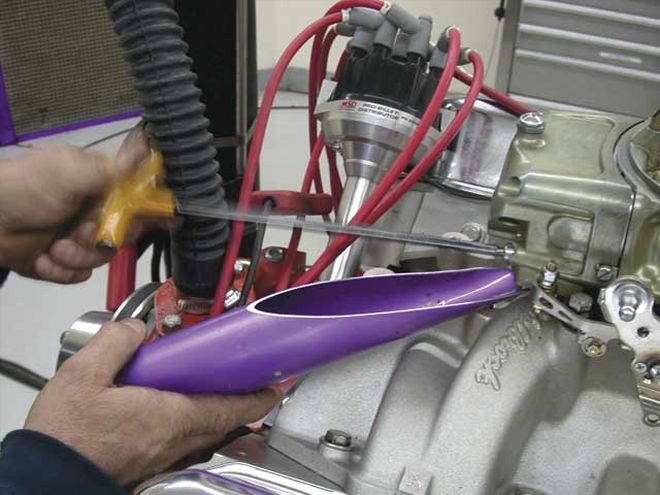 To change the jets, the float bowls are removed to access the meteringblocks. Removing either of the lower bowl retaining screws will allowthe fuel to drain. A catch tube, such as the one shown, is handy forcatching the fuel.
To change the jets, the float bowls are removed to access the meteringblocks. Removing either of the lower bowl retaining screws will allowthe fuel to drain. A catch tube, such as the one shown, is handy forcatching the fuel.
WHAT IS IT: High speed or main air bleed.
WHO SHOULD CARE: Carb experts or very serious tuners.
WHAT IT DOES: Draws air into the main circuit.
WHAT CHANGES DOES IT MAKE: Larger bleed leans the mixture, but can alsodelay the main circuit activation and alter the fuel curve in a givenrpm range; smaller bleed will do the opposite.
TUNING TIPS YOU NEED TO KNOW: Fixed drilling in street carbs,replaceable on high-end race units. Air bleed tuning will alter the mainjet requirement. If the jet sizes are out of the normal range, an airbleed change can sometimes regain jet sensitivity. Changes to jet andair bleeds worked in unison can sometimes dial-in a jet/bleedcombination that shows more power, even though the fuel-mixture ratioreads little changed. Air bleed changes can affect booster signal andsensitivity, and timing. Instrumented dyno regimes are the territory oftrue air bleed tuning. Other than that, it's a shot in the dark.
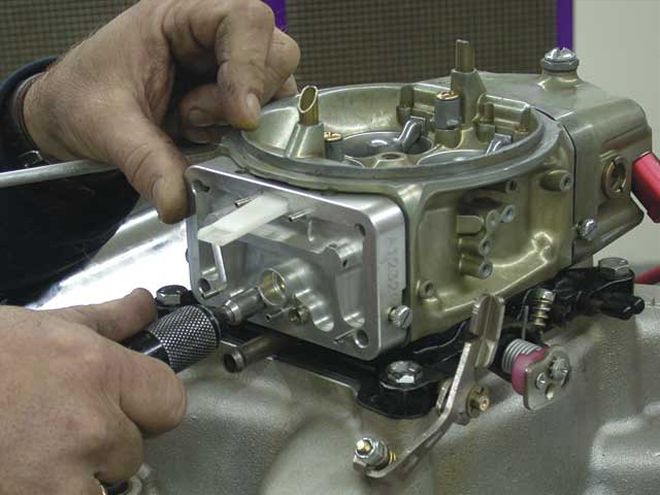 The jets (shown being removed here) are simply unscrewed and replacedwith others having a larger or smaller orifice size, altering the fuelquantity delivered. We swapped the jets several times to find the bestWOT mixture and power.
The jets (shown being removed here) are simply unscrewed and replacedwith others having a larger or smaller orifice size, altering the fuelquantity delivered. We swapped the jets several times to find the bestWOT mixture and power.
WHAT IS IT: The booster.
WHO SHOULD CARE: the guy with a removable sleeve carb, or custom carbwizards.
WHAT IT DOES: The booster, along with the main venturi, create thepressure differential that draws the fuel through the main circuit.Bernoulli laid down that law.
WHAT CHANGES DOES IT MAKE: Booster design changes the sensitivity of themain circuit.
TUNING TIPS YOU NEED TO KNOW: Not an item normally changed, butreplaceable in some high-end carbs. In the replaceable venturi carbslike the RS, the booster should be changed to match the venturi.Boosters of various discharge nozzle sizes, all of the downleg design,are spec'd for a corresponding venturi diameter. Annular boosters canalso be substituted for an especially sensitive and caring delivery offuel.
WHAT IS IT: Emulsion bleed.
WHO SHOULD CARE: Carb gurus who know what they are doing, pro carbtuners, or neurotics unafraid of ruining their carb.
WHAT IT DOES: Controls the fuel curve of the main circuit.
WHAT CHANGES DOES IT MAKE: Alters the timing, sensitivity, and shape ofthe main circuit fuel curve.
TUNING TIPS YOU NEED TO KNOW: Fixed drillings in most carbs, replaceablein high-end units. Larger bleeds give a leaner, more emulsified maincircuit mixture, and quicker timing earlier in the curve. Smaller bleedshave the opposite effect. The bleeds nearer the bottom affect high-rpmmixture more than the upper bleeds. This is the realm of high-endinstrumented testing only.
THE COMBO
Our engine combination was designed as a pump-gas performer,using off-the-shelf, bolt-on components. The bottom end is veryconventional, featuring a production 440 block bored .030-inch over fora final displacement of 446 ci, using a stock 440 forged crank. Stock440 LY rods, resized and upgraded with ARP bolts, carrying SpeedPro 2355forged pistons and file-fit SpeedPro rings with the block decked forzero deck. The cylinder heads are box-stock Edelbrock closed-chamberunits, bolted on with Fel-Pro composition gaskets to provide a quenchclearance of .039-inch. Compression ratio calculates to 10.2:1, andyields a cranking compression of 178 psi. Induction is handled by anas-cast Edelbrock Performer RPM intake, topped with the featured RaceDemon RS carb, and fitted with the largest venturi sleeves for a rated1,050 cfm.
The camshaft is a custom Competition Cams solid flat tappet,ground on the aggressive MM-series masters, numbers 6581 intake and 6583exhaust. Intake/exhaust specs are 265/273 rated duration, 239/247duration at .050-degrees duration, .573/.597 gross lift, with the camground at 110-degrees lobe separation and installed at 106-degree intakecenterline. The 1.6:1 ratio aluminum roller rockers were also from CompCams, while the pushrods are the work of Smith Brothers. We found theperformance of this cam combo to be outstanding. Finishing touches tothe engine include an MSD ignition system, wires, and distributor, and aset of tti 17/8-inch headers. Augmenting an otherwise stock lubricationsystem is a Milodon pump, pan, and windage tray. A TCI rattler dampermakes some noise, while providing SFI certification for the dragstrip.All in all, we have a simple-to-build 440, one that delivers astreet-easy 11 inches of idle vacuum, while boiling the dyno at 560lb-ft of torque and another 560 on the horsepower scale. Nice.
POWER NUMBERS
TORQUE
SUPERFLOW 901 ENGINE DYNOTESTED AT WESTECH
RPM BASELINE/ TUNED
3,000 503/ 510
3,500 534/ 546
4,000 547/ 561
4,500 536/ 551
5,000 521/ 536
5,500 507/ 525
6,000 472/ 487
6,500 429/ 443
HORSEPOWER
SUPERFLOW 901 ENGINE DYNOTESTED AT WESTECH
RPM BASELINE/ TUNED
3,000 287/ 291
3,500 356/ 364
4,000 416/ 427
4,500 459/ 472
5,000 496/ 511
5,500 531/ 550
5,900 542/ 560
6,000 539/ 557
6,500 515/ 531
*Bold Numbers Peak
AIR/FUEL RATIO
AVERAGE 3,000-6,300 RPM
BASELINE 12.8
TUNED 13.2